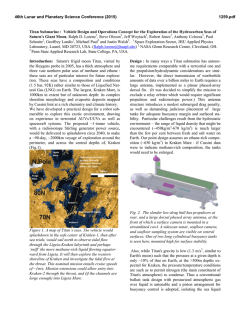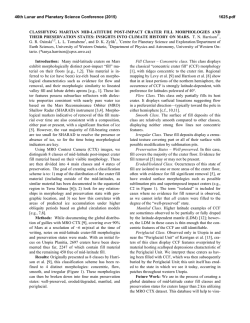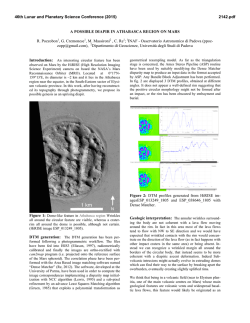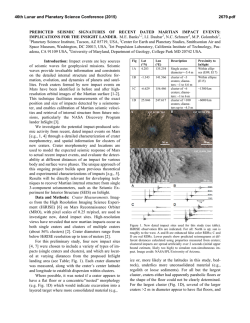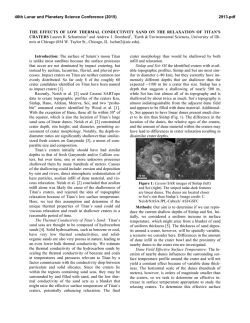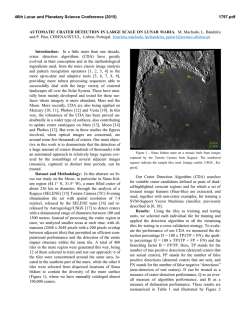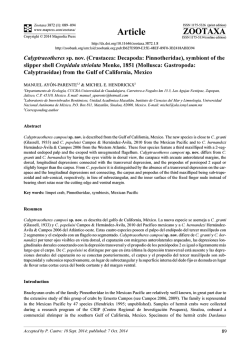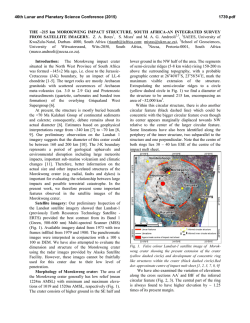
A VARIETY OF SHAPES – A SINGLE ORIGIN?
46th Lunar and Planetary Science Conference (2015) 2490.pdf NORTH POLAR CRATER AND LAKE BASINS: A VARIETY OF SHAPES – A SINGLE ORIGIN? C. A. Wood1, 1Planetary Science Institute, Tucson, AZ 85719; [email protected]). Introduction: The north polar region of Titan is remarkable for possessing hundreds of bodies of liquid. Most liquid is contained within three large seas, Kraken, Ligeia and Punga, but hundreds of other lakes occur in much smaller depressions, and many other apparent dry lake beds occur. This study investigates the shapes and origins of these smaller depressions and questions if they are part of a continuum with a single origin, or if they have multiple, unrelated origins. Observations and Prior Work: The majority of small lakes are found in two broad patches roughly centered at 75°N, 140°W and at 80°N. 40°W, although smaller concentrations of hundreds of lakes and dry lake depressions are found in many locations north of 50°N latitude. A distinctive type of lake-containing depression is approximately round in outline, 10 to 30 km across, with sunken floors, often at different levels. This morphological type of feature previously has been interpreted as either karst depressions or volcanic craters [1]. However, the overall suite of morphological characteristics, plus recent evidence from stereomapping that identified elevated rims, strongly supports a volcanic origin for this type of depression [2]. Almost always near these crater-like depressions are others with irregular shapes that include some curved edges. An excellent set of examples occur near 125°W, 75°N (Fig. 1). Two small, lake-filled depressions near bottom center (labeled A) are classic volcanic crater type features, surrounded by halos of radar-bright material which stereogrammetry shows is elevated, like rims. Nearby are similar craters, some with lakes (indicated with blue in these excerpts from a north polar mosaic compiled by R. Kirk), and some without. At top left is a larger feature (B) with two curved edges on the left but a more complex opposite side. This central depresssion is also surrounded by bright, elevated terrain. At C are other complex shaped depressions, some with crater-like edges; these irregular features appear to have coalesced from multiple smaller original depressions. Figure 2 shows such interconnected depressions with lakes and others with darker, non-lake, floors interpreted as dried lake deposits [3]. A significant question is if these irregular shaped depressions have the same origin as the smaller, circular ones. Another common feature of depressions best seen when they have lakes (Fig. 3), is that the walls between adjacent ones are often interconnected with each other via liquid, with liquid connecting one to the other. The Kissing Lakes, or more formally Abaya Lacus (Fig. 3), Fig. 1: Multiple types of depressions near 125°W/ 75°N. A: Two volcanic crater-like features each 8 to 10 km in diameter. B: Complex depression with rounded edges on left, but not on the right. C: Multiple depressions with and without curved elements that could be remnant interlocking craters. Fig. 2: Many interlocked lake depressions at about 180°W/70°N. Image width about 150 km. at 47°W/73°N, is a famous example, with two or more interlocking craters having their deepest areas joined by a channel of liquid. Lakes Sotonera, Sparrow, Waikare and Myvatn are four other nearby crater-like complexes with similar breaching of walls by liquids. Interpretations: There is considerable evidence [2] that the circular-shaped, elevated rim depressions (A in 46th Lunar and Planetary Science Conference (2015) Figure 1) formed as volcanic craters, and we interpret the other features (B and C of Figure 1, and in Figures 2 and 3) as modifications of such original volcanic morphology. (The depressions holding the large seas show no evidence of being coalesced craters.) Additionally, the common breaching of crater walls as seen in Figures 2 and 3 suggest that rim material is not solid, as many terrestrial crater rims are, with ash and other ejecta deposits being cemented together by clays or anchored by lava flows. Perhaps the Titan rim deposits that create the elevations circling the central depressions are uncemented deposits of fragmental ejecta and thus are easily erodeable. That would be consistent with the widespread occurrence of river valleys, seen nearly everywhere and at all scales, including the descent images from Huygens [4]. Additionally, the Huygens landing site surface is apparently made of unconsolidated sediments, suggesting that many surface units of Titan are friable. If the the majority of the non-circular depressions in the north polar region of Titan are of volcanic origin, since then heavily modified by fluvial, dissolution or perhaps even karstic processes, then volcanism would be a much more important process on Titan than previously thought, and the north polar area would be the largest recognized volcanic province on the world. There are a number of questions to be considered if volcanism is determined to be responsible for the widespread occurrence of depressions in the north polar regions. Most significant is, why there? It may be that the low elevation of the pole, proposed higher heat flow and even the abundance of liquids may be involved [2]. A second question is why there are no extrusive volcanic features. The answer may be that volcanic flows abound, but without high resolution to detect flow boundaries, they can not be recognized. And if evidence ultimately suggests that flows exist in this polar region it could be that they are widespread across Titan. References: [1] Mitchell K. L. et al. (2008) LPS XXXX, 2064–2065. [2] Wood, C. A., Radbaugh, J. & Kirk, R. (in prep.). [3] Hayes A. G. et al. (2008) Geophys. Res Let. 35, 9204-9208. [4] Aharonson O. et al. (2014) in Titan (ed by Muller-Wodard, Griffith, Lellouch and Cravens. Cambridge). 2490.pdf Fig. 3: Joined lakes where channels between separate depressions allow fluids to interconnect. Each of the Abaya Lacus circuar depressions, partially filled with liquids, is about 25 km in diameter.
© Copyright 2026
